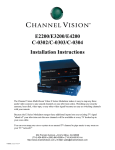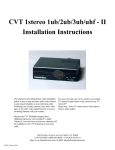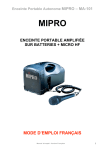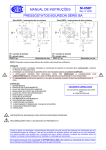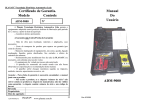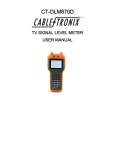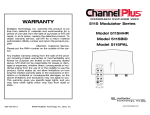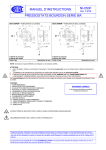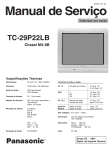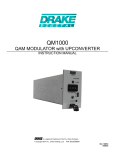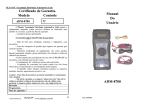Download C-0301 Instruction Manual - Channel Vision Technology
Transcript
E SERIES 1200 Installation Instructions 234 FISCHER AVENUE z COSTA MESA, CA 92626 (714) 424-6500 z (800) 840-0288 z (714) 424-6510 FAX http://www.channelvision.com z E-Mail: [email protected] © 2001, CHANNEL VISION™ Channel Vision ! CAUTION E1200 Tested To Comply With FCC Stan- RISK OF ELECTRIC SHOCK FOR HOME OR OFFICE USE DO NOT OPEN CAUTION: TO REDUCE THE RISK OF ELECTRIC SHOCK, DO NOT REMOVE COVER. PROPER VENTILATION REQUIRED. NO USER-SERVICEABLE PARTS INSI DE. REFER SERVICING TO QUALIFIED SERVICE PERSONAL. Note: This equipment has been tested and found to comply with the limits for a Class B digital device, pursuant to part 15 of the FCC Rules. These limits are designed to provide reasonable protection against harmful interference in a residential installation. This equipment generates, uses and can radiate radio frequency energy and, if not installed and used in accordance with the instructions, may cause harmful interference to radio communications. However, there is no guarantee that interference will not occur in a particular installation. If this equipment does cause harmful interference to radio or television reception, which can be determined by turning the equipment off and on, the user is encouraged to try and correct the interference by one or more of the following measures: • • Reorient or relocate the receiving antenna. Products to be installed by certified dealers only. Certification Requirements: Must be professional installing dealer, pass • certification test and familiar with TV and antenna systems. Call 800/840- Connect the equipment into an outlet a circuit different from that to which the receiver is connected • Consult the dealer or an experienced radio/TV technician for help. 0288 for Channel Vision Training Manual and certificat ion test. Thank you for choosing Channel Vision! Our E-1200 is the finest miniature digital RF modulator available today and accepts one audio/video input for modulation onto the channel of your choice. Channel Vision’s digital circuitry provides for simple installation and years of trouble-free performance. The E-1200 offers the widest channel range in the class (UHF 14-78 and Cable 65-135) and includes the highest power output (30dBmV) providing a strong signal for long cable runs. A built -in audio impedance adjustment is also included for true stereo audio loop through. Simply follow the installation instructions below and you will enjoy the convenience of Channel Vision for years to come! Installation Instructions Step 1: Find an unused channel between 65-135 for cable or 14-78 for UHF. Step 2: Be sure that there is no interference on your selected channel. We recommend the use of a block filter (model #3102) to provide “clean” channels for modulating to. Step 3:Set the jumper on the back side of the unit for the desired band: UHF Antenna or CATV. Step 4: Select TV band by inserting jumper into "CATV jumper" (ch 68-135) or "Antenna jumper" (ch 14-78) location on the back of the unit. Default setting is cable band. Step 5: Change the modulator channel; push and hold the select button for three seconds until power LED on front flashes then press CH- or CH+ to select the channel. NOTE: Up and down buttons are in increments of one. Step 6: Combine the RF output to the cable or UHF feed using a Channel Vision broadband combiner. (see diagram) Increase the separation between the equipment and receiver. Step 7:Mount modulator to a wall or cabinet System Design Considerations Sophisticated home "networks" involving many TV sets are feasible with the CVT modulator, but care must be taken to design an optimum TV signal distribution system. TV sets are designed for signals around 10dBmV. Signals below 0dB result in weak, fuzzy, snowy pictures. Signals above 10dBmV may overdrive older TV sets which don't have modern automatic gain controls. An inline attenuator (pad) can be used to reduce these signals, and to balance radically different signal strengths at all your TV's. Signal strength decreases with coax cable length and through connectors, splitters, and combiners. It's important to determine how much cable and what in-line devices you'll be using and adjust your input signal levels with amplifiers at the front end or in-line on your network to compensate for the line losses. (The charts on the back of these instructions will help you calculate likely losses through coax cable runs and splitters). In-line amps are powered through the coax cable and can be used to achieve modest signal strength gains; more powerful a/c powered amps offer more amplification (and usually adjustable gain and tilt too). Your system should provide 10dBmV to every TV (maximum is 15.5dBmV, per the FCC). Reverse isolation is used to prevent the modulator signal from leaking out to the antenna or cable input. Reverse isolation is accomplished by placing an amplifier between your antenna or cable E Series 1200 Basic Setup company input and the CVT combiner. This prevents the CVT signal from propagating back up the input line. Another way to prevent leakage from your system is to cap all unused coax cable ports on you network with appropriate terminators. Cable or Antenna AV In 3102 Filter Modulator Channel Vision MULTI ROOM VIDEO TECHNOLOGY CVT - 15PIA RF Out HS-2 Bandpass filters stop unwanted frequencies while passing all others along. They're handy if a channel you want to use for a CVT source is already in use. Taps are used to redirect a portion of a signal from the "main" trunk line while passing the remaining signal strength through. For example, a 12dBmV tap would pass 29dBmV from a 30dBmV trunk line signal and pass the remaining 18dBmV to a branch line. (Minor signal loss of 1dB would occur in the trunk line leaving 29dBmV.) Demodulators are used to demodulate the output of a cable box converter, making it possible to assign the cable signal to any channel (cable boxes usually limit your choices to channel three or channel four). Use a demodulator to "condition" the cable signal before assigning it to a CVT input line. HS-8 Satellite Receiver Adjustments To TV's FCC Regulations – the Cable TV Act “Cable home wiring” is the cable wiring located inside a Cable TV subscriber’s home or apartment that has been installed by a cable operator or its contractor. It does not include such items as amplifiers, converters, decoder boxes or remote control units. Video Level Adjustment: Adjust the incoming video source base band level. Use only to increase brightness and balance the channels for consistent contrast. Channel Up/Down: Changes the modulated channel. Press and hold Select for 2 seconds or until front light blinks to allow channel up/down to work. Channel Push Cable/UHF After a subscriber voluntarily terminates cable service, the cable operator may take one of two action: 1. Leave the home wiring in place. 2. Notify the consumer that it will remove the wiring unless the consumer purchases it from the cable operator on a per-foot re placement cost basis. If the wiring was previously transferred or sold to the subscriber, the subscriber owns it; and the cable company cannot remove it or restrict its use, regardless of the reason for service termination. If the subscriber does not already own the wiring and declines to purchase it from the cable operator, the cable operator may remove the home wiring within 30 days of the subscriber’s refusal. The cable company must remove the wiring at no charge to the subscriber, and must pay the cost of any damage caused by removing the wiring. To leave the wiring inside and remove the wiring outside a subscriber’s home, a cable operator may, for single unit dwellings, sever the cable approximately 12 inches outside the point where the cable enters the outside wall of the subscriber’s home. For multiple unit dwellings, the cable operator may sever the wire approximately 12 inches outside the point where the cable enters the subscriber’s individual dwelling unit, except in cases of “loop-through” or other similar series wire configurations that are not covered by the home wiring rules. Channel Push Cable/UHF Channel Push Cable/UHF Channel Push Cable/UHF 65/14 Factory Preset 80/29 Up 15 95-99/42 Not Used 118/61 Down 18 66/15 Up 1 81/30 Up 16 100/43 Down 36 119/62 Down 17 67/16 Up 2 82/31 Up 17 101/44 Down 35 120/63 Down 16 68/17 Up 3 83/32 Up 18 102/45 Down 34 121/64 Down 15 69/18 Up 4 84/33 Up 19 103/46 Down 33 122/65 Down 14 70/19 Up 5 85/34 Up 20 104/47 Down 32 123/66 Down 13 71/20 Up 6 86/35 Up 21 105/48 Down 31 124/67 Down 12 72/21 Up 7 87/36 Up 22 106/49 Down 30 125/68 Down 11 73/22 Up 8 88/37 Up 23 107/50 Down 29 126/69 Down 10 74/23 Up 9 89/38 Up 24 108/51 Down 28 127/70 Down 9 75/24 Up 10 90/39 Up 25 109/52 Down 27 128/71 Down 8 76/25 Up 11 91/40 Up 26 110/53 Down 26 129/72 Down 7 77/26 Up 12 92/41 Up 27 111/54 Down 25 130/73 Down 6 78/27 Up 13 93/42 Up 28 112/55 Down 24 131/74 Down 5 79/28 Up 14 94/43 Up 29 113/56 Down 23 132/75 Down 4 114/57 Down 22 133/76 Down 3 115/58 Down 21 134/77 Down 2 116/59 Down 20 135/78 Down 1 117/60 Down 19 Channel up and down buttons are in increments of one. The E-1200 is factory set for CATV 65. If the cable company fails to remove the wiring within 30 days of the subscriber’s refusal to purchase it, the cable operator forfeits its right to the wiring and may not remove it or restrict its use at any later time. A cable operator will not be held responsible for any signal leakage that occurs from the home wiring once the cable operator ceases providing service over that wiring. System Installation Checklist 1. Try for 10dB of signal strength at each television. Use a little more for big screen TV's. Remember, Uncle Sam doesn't like more than 15.5dB of signal going into any TV. 2. When laying out your system, there will be approximately 5dB of signal loss per 100' of RG6. 3. Be sure ALL of your splitters and amplifiers are broadband. Splitters should be 5MHz to 1GHz, and amps should be 40MHz to 1GHz. 4. Check and make sure that all televisions are set up for the proper frequency spectrum (i.e. UHF or cable). 5. Make sure that the channels you want to modulate on have “clean snow“. No lines or interference. 6. Use a low pass filter on every installation to clean up the frequencies the modulator will be assigned to and keep any potential interference out of the system. Model 3102, cleans up channel 64, 84, 105 and above. 7. Allow 1 to 2 channel spacing between modulated channels and "active" channels. 8. Always compensate for insertion loss with splitters and taps. There will always be a drop in antenna/cable signal strength when combining a modulator to an existing system (because of insertion loss with the combiner). Loss Key_______ 9. When combining Coax an existing signal with RG6 per 100' 4dB a modulated RG59 per 100' 5dB signal, make sure to have equal signal Splitter strength at the point of HS-2 3.5dB the combiner HS-3 5.5dB so one signal does HS-4 7dB not degrade the other HS-6 9.5dB and cause beat HS-8 11dB Taps - Pass Thru -1dB Suggested dB level @ TV 8~15dB Maximum of 15.5dBmV per FCC Regulation frequencies. 10. When possible, use the lowest frequencies available for the modulated channels. Lower channels (frequencies) have lower signal loss on the cable runs. 11. When in doubt, run the signal a little high to the television and use an attenuator to lower the signal strength going into the TV. Attenuators may be combined (i.e. two -3dB attenuators. will equal -6dB). 12. Make sure to use a well shielded coax of either RG-6 Quad or RG-11 for long trunk runs. 13. Use RG59U Coax for composite/baseband video signals only. 14. Combine the modulator into the video distribution system as far "up-stream" as possible. 15. If the system needs to be amplified use the amplifier as far "upstream" as possible. Trouble Shooting Trouble shooting any system can make or break the entire installation. Here are the most common problems and solutions. After trying these solutions, call 800/840-0288 for 24 hour technical assistance. Calls before 8am and after 5pm pacific standard time will be returned by the technician on call. Snowy Picture : No Modulation This is a problem of the TV and the modulator not "talking" to each other. 1. Verify the modulator is set up for the proper TV channel band (Cable TV or antenna). Set the channel badn by inserting the jumper on the back of the unit to the desired location ("CATV sjumper" or "Antenna jumper"). The unit must be powered down to change to a different setting. 2. Verify the TV is set up on the proper TV channel band. Use "Air" for UHF channels or Cable for Ultraband channels . The TV will have an on screen set-up menu or a switch for this function. Also make sure the modulated channel isn't blocked out by auto-programming. To check for the TV being set to the wrong band, go to the equivalent channel on the other band (i.e. to check 65 cable try 14 UHF). Add 51 channels for antenna connection to cable channels. 3. Check TV manual to make sure TV works on channel above 65. 4. Check all connections for a good connection. 5. Check splitters and amplifiers for 1GHz rating. 6. Try another TV, bypass all components and go directly into TV. Black Picture : No Modulation In this case, the TV and the modulator are "talking" to each other. The video signal is not being passed through the system. 1. Verify good connections to the modulator from the video source i.e. VCR. 2. Check video source (VCR, Sat Receiver etc.) by running the outputs directly into the video inputs on the TV. Verify video source is working. 3. Check for power at video source. 4. Disconnect modulator from system: A) Picture goes to snow, problem is between video source and inputs on the modulator. B) Picture stays black, hook up the modulator. directly to a TV eliminating all the components of the system and check the picture. Grainy Local Channels : Good Modulated Picture 1. Disconnect the modulator from the system and connect the local channel feed directly to the distribution system and check TV picture quality. A) If the picture quality is good the insertion loss of the combiner for the modulator is degrading the local channel signal. Use a CVT-15PIA to compensate for the insertion loss. B) The other alternative is to use a 6dB tap as the combiner, put the local channel feed on the pass through port for a minimal loss of signal connect the modulator to the tap off port. C) If the picture is still bad, check for a bad connection where 2. leakage may occur or if the shielding braid is touching the center conductor. Install model CVT-15PIA amplifier after the combiner. Grainy Modulated Channel : Good Picture on the Cable Channels 1. Disconnect cable channels from the system and check the modulated channels. A) If the modulated channels are good, use a low pass filter to "clean-up" the incoming frequencies to be modulated. B) If the modulated channel does not improve after disconnecting the local channels, evaluate signal loss of modulator through the splitters and cable length of the system. Amplify after the combiner if needed. C) Also check the connections between modulator and the combiner for leakage or the cable braid is touching the center conductor. 2. Make sure the attenuator adjustment on the back of the modulator is turned to maximum output power. 3. Check output strength with field strength meter. 4. Connect modulator directly to TV and check picture quality. 5. Check bandwidth of all splitters and amplifiers for 1GHz capability. 6. Place TV cable setting on standard, NOT HRC or IRC. TV Won't Tune High Enough to get Modulated Channel 1. Use an external tuner i.e. VCR or a Cable Box converter tuner to allow the TV to view a modulated channel on a channel through the external tuner. 2. If the modulated channel is beyond the capabilities for that TV, the TV will not work with the system. Cable Company Box Won't Pass a Modulated Signal 1. Connect modulator directly to TV and verify the modulator is sending a signal the TV can receive. 2. Use model 3101 Cable Box Combiner Kit to route the modulated signal around the cable box. See schematic page. Cable Company Uses All Available Channels 1. Use a low pass filter (3102) to block out channels 80 and above for clean modulation (won't effect channels 95-99). 2. Call for pricing on a custom filter to block out a specific channel or multiple channels. Modulated Picture is Too Bright or Washed Out 1. Adjust the white video level. Adjust port on the chassis located under the white cover plate above the channel select to the proper brightness. 2. If using a camera, check positioning of the lens to be sure it's not aimed at the sun or a reflection. 3. Adjust camera lens - see lens manual. Modulated Picture is Too Dark 1. If baseband video is being split with a Stereo Loop Kit or loop through quad, set impedance matching switch or potentiometer (termination switch) to 1ΚΩ. 2. Adjust the white video level adjust pot on the chassis located under the white cover plate above the channel select to the proper brightness. 3 Check all connectors for 75Ω. Noise on the Audio 1. Insert grounding block in line and ground coax cable before it enters the TV. 2. Use professional grade audio/video interconnect between the components and the modulator. O u c h!!! Audio is Too Low Use a Y-Connector to combine the left and right audio before entering the modulator. Herringbone in Picture on Modulated Channel Disconnect modulator from local channels an check modulated channel. A) If there is programming move the modulated channel. B) If the picture is snowy, use a #3102-80 low pass filter to block noise or data coming in from cable company. C) Separate modulated channels by two channels. Horizontal Bars Rolling Through TV Picture 1. Check for a component of the system to introduce DC power into the system. Disconnect that component and check TV. If the hum bars stop, use a DC blocker down stream from that component to block the power from getting to the TVs. 2. If the rolling is only on the modulated channels, check for impedance mismatch by adjusting the video level adjustment pot. Vertical Bars Rolling Through TV Picture Check for AC power getting on the line. Use a ground breaker in line. Black and White Lines on one Local Channel Move modulated channel up to a new channel. If problem persists and all of the inputs of a multiple input modulator are not being used, check default channels on modulator to see if default channel is set to the same channel that the problem channel is set to. Flashing at the Top or Middle of TV Picture 1. If flashing is on modulated channels, turn up attenuator/ down gain of modulator. 2. If flashing is on local channels, attenuate output of amplifier. 3. Remove cable TV from system. If flash stops, install filter #3102-__ to fix problem. Picture is Tearing Possible impedance problem. Check that impedance switch is set to 75Ω. Ghosts on the Picture 1. Terminate all unused ports with 75Ω terminator model 2101. 2. Check for low quality combiner in system. Replace with high isolation combiner, HS model combiner. Channel Vision Limited Warranty Channel Vision Technology will repair or replace any defect in material or workmanship which o ccur during normal use of this product with new or rebuilt parts, free of charge in the USA, for two years from the date of original purchase. This is a no hassle warranty with no mail in warranty card needed. This warranty does not cover damages in shipment, failures caused by other products not supplied by Channel Vision Technology, or failures due to accident, misuse, abuse, or alteration of the equipment. This warranty extends only to the original purchaser. A purchase receipt, invoice, or other proof of original purchase date will be required before warranty repairs are provided. Mail in service can be obtained during the warranty period by calling toll free (800) 840-0288 toll free. A Return Authorization number must be obtained in advance and be marked on the outside of the shipping carton. This warranty gives you specific legal rights, and you may have other rights (which vary from state to state). If a problem with this product develops during or after the warranty period, please contact Channel Vision, your dealer, or any factory-authorized service center. Specifications: RF Modulator Video Audio PLL Synthesized Oscillator NTSC L&R Monaural/Stereo loop opt. Video Performance Differential Gain Less than 2% (0.2dB) RF Carriers Frequency Stability Frequency Ranges Differential Phase Signal/Noise Ratio Less than 3 degree Greater than 52dB +1KHz UHF 471.25-855.25MHz Spurious Output Rejection Outside Carrier +12MHz Greater than 70dBC Inside Carrier +12MHz Greater than 55dBC Isolation Greater than 70dB Channels Channel Width Audio Offset Sidebands Ultraband 469.25-859.25MHz UHF 14-78, Ultraband 65-135 (Exc. 95-99) 6.0MHz 4.5MHz Double RF Output Maximum Gain Range Video Output 30dBmV Fixed 1VPeak to Peak Audio Output 1V RMS Channel Selector Up/Down selector buttons/I Increments of one Inputs Video Audio 0.4V-2.7V Peak to Peak 1V RMS Connectors Video In Audio In RF Output RCA Female RCA Female F type female Operating Temperatures 0oC to 50oC Transformer Input Input Voltage Power Output Voltage 115 VAC, 50/60Hz 8 Watts 12 VDC @ 250mA 500-166 rev B






